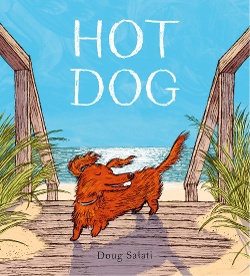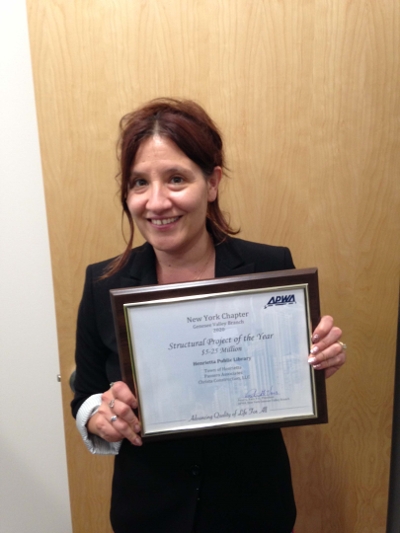Adrienne L. Pettinelli follows the emotional arc in Doug Salati's Hot Dog, one of the most expressive and empathetic picture books of the year — and one the Caldecott committee is surely spending time with.
[Many Calling Caldecott posts this season will begin with the Horn Book Magazine review of the featured book, followed by the post's author's critique.]

 Hot Dog
Hot Dog
by Doug Salati; illus. by the author
Preschool, Primary Knopf 40 pp. g
5/22 978-0-593-30843-1 $17.99
Library ed. 978-0-593-30844-8 $20.99
e-book ed. 978-0-593-30845-5 $10.99
It’s a hot time in the city. A small, low-slung pup greets the morning from the window of a narrow NYC brownstone. But as the dog’s day unfolds, it all becomes too much. “City summer / steamy sidewalks… / crowds close in… / too loud / too close / too much!” Fortunately, the dog’s devoted owner understands. She breaks off her round of errands mid-crosswalk, picks up her dog, and takes a taxi, then a train, and finally a ferry to an island, “wild and long and low,” where the pair enjoys an idyllic beach day. The dog runs and runs, chases waves, delivers shells and stones to its owner, digs holes; the woman relaxes under an umbrella. Restored, they return to the city in the evening, now able to cherish its many pleasures—skateboarders in the park, street pretzels, a fruit stand. “What a day for a dog!” Minimal, impressionistic free-verse text beautifully sets scenes and conveys character and emotion, expertly matched by the illustrations. Claustrophobic vertical panels, angular lines, and hot oranges, reds, and yellows (of the city) give way to expansive, sometimes full-spread horizontal panels and cool blues and greens (of the island escape). In the end, back home in the woman’s small walk-up apartment, our doggo settles down for the night, “ready to leap / into a deep / ocean / sleep.” Entirely delightful; a breath of fresh air from start to finish. MARTHA V. PARRAVANO
From the November/December 2022 issue of The Horn Book Magazine.
This year’s Caldecott committee members are surely spending time with this expressive and empathetic book. In her review, Martha talks about the visual shift between the initial city scenes and the rest of the book; let’s take a closer look at that.
The emotional arc of this story finds our main character, this Dachshund-esque dog, moving from a feeling of oppression to one of freedom and joyful ease. In the first spreads, Salati locks owner and dog in panels with thick, dark pencil borders. Lines and figures sometimes extend outside the panels, where they lose form — such a clever and effective method to visually convey the way one’s ability to take in sensory information narrows when under extreme stress, as this dog certainly is. This is something children experience, though most have no words for it; expressing the feeling through images is the right choice for this audience. (Do I need to mention that this dog is a dog but also a stand-in for a child? No? Great.) The dog’s yellow leash is echoed in the yellow line of the road and the caution tape that surrounds a construction zone in one of the panels: all things confining the dog and telling it where to go. The panels in this section are, as Martha notes, claustrophobic. I’d even call them cluttered. There is no space within them for the eye, or our main characters, to rest. But again we see the consideration of child readers in the white space that surrounds each panel and gives a restful, clear spot for the text to live. The characters in this book are overwhelmed, but its readers aren’t.
Then there is this beautiful shift that begins with an image of the dog and its owner eye-to-eye in the middle of the street. What a heartfelt moment of connection! I do this with my own dog when he’s worried, and I do it with children when they’re upset — get down on their level, give them something to focus on. The next image is the first in the book to break out of panels, into a full bleed image of the owner calling for a taxi — the chaotic background is gone altogether, and all we see here is dog and owner. On the page-turn, we’re still in the city, so those panels with the heavy borders are back, but the colors are significantly toned down and the backgrounds are less cluttered. A moment of empathy has made the situation more tolerable.
Then comes the page-turn that reveals a train ride that turns into a ferry ride in three strips of borderless panels. The heavy pencil lines and the solid yellows and reds that dominated the illustrations up to this point are gone. Now we have visible, watery brushstrokes in cool blues. The effect is like a breeze coming in and sweeping away a hot, humid day. This more relaxed style prevails throughout a series of spreads in which owner and dog walk, lounge, and play at the beach. There’s a lovely reprise of owner and dog eye-to-eye, this time in the sand over a pile of rocks. This pair of images both express love and connection, the things that endure as the context changes — a powerful, quiet concept communicated entirely without words.
In terms of Caldecott criteria, I see excellence of technique, of pictorial interpretation, and in delineation of plot, theme, characters, and setting. I see strong recognition of and respect for a child audience. We live in a time of constant demanding sensory stimulation, and many children — particularly the very young — are easily overwhelmed by so much sensory input. I was one of those children myself, so I appreciate a book that speaks so lovingly to those kids and those feelings.

ALREADY A SUBSCRIBER? LOG IN
We are currently offering this content for free. Sign up now to activate your personal profile, where you can save articles for future viewing.








Add Comment :-
Be the first reader to comment.
Comment Policy:
Comment should not be empty !!!